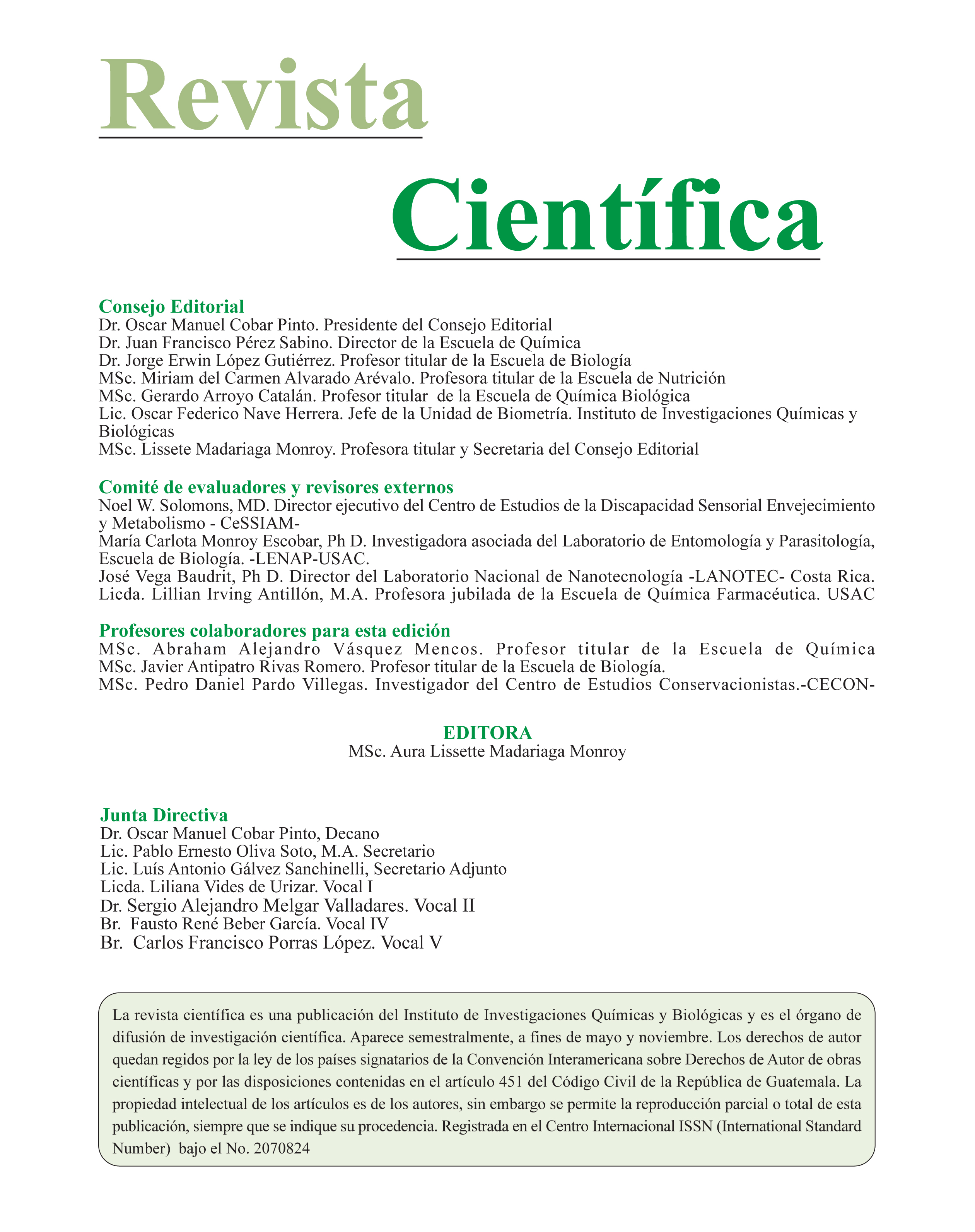Dermatophytes and dermatophytosis Frequency in Guatemala during the period May 2008 to June 2009
DOI:
https://doi.org/10.54495/Rev.Cientifica.v22i1.118Keywords:
Dermathophytosis, dermatophytes, onychomycosis, T. rubrumAbstract
Dermatophytosis are infections caused by dermatophytes. A group of fungi with a worldwide distribution. In order to know the frequency of fungal infections due to dermatophytes a retrospective observational descriptive study was carried out with a cohort of 2418 cases reported by “Candelaria Hospital Center”, the Ministry of Public Health and Social Assistence and Institute of Dermatology and skin Surgery "Prof. Dr. Fernando A. Cordero C.". Trichophyton rubrum was isolated in 85%, followed by Microsporum canis (7%) and Trichophyton mentagrophytes (5,92%), and tinea unguium (onychomycosis) was the most common dermatophytosis (57.85%), and the distal /lateral subungual onychomycosis (26,96%) was the most frequent clinical form. The most affected age range was 30-39 years. This study contributes to increase the epidemiological information of dermatophytosis and their etiological agents.
Downloads
References
Ameen M. (2010). Epidemiology of superficial fungal infections. Clinics in Dermatology, 28(2), 197-201. https://doi.org/10.1016/j.clindermatol.2009.12.005 DOI: https://doi.org/10.1016/j.clindermatol.2009.12.005
Arenas R. (2008). Micología Médica Ilustrada. México: Editorial McGrawHill. México. p 61-77.
Sigurgeirsson, B. y Steingrímsson, Ó. (2004) Risk factors associated with onychomycosis. Jornal of the European Academy of Dermatology and Venereology. 18, 48-51. https://doi.org/10.1111/j.1468-3083.2004.00851.x DOI: https://doi.org/10.1111/j.1468-3083.2004.00851.x
Bonifaz A. (2010). Micología Médica Básica. México: Editorial McGrawHill. p. 61-93.
Bussy R. Gatti C. y Guardia C. (2011). Fundamentos en Dermatología Clínica. Argentina: Editorial Ediciones Journal. P. 31-34.
Carrillo-Muñoz, A. y Tur, C. (2001). Hongos dermatofitos: aspectos biológicos. Actualidad Dermatológica, 4, 687-694.
Gürcan, S. Tikve li, M. Eskiocak, M. Kiliç, H. y Otkun, M. (2008). Investigation of the agents and risk factors of dermatophytosis: a hospital-based study. Mikrobiyol Bul 42, 95-102.
Martínez, R. Manzano, P. Hernández, F. Bezán, E. y Méndez, J. (2010). Dynamics of dermatophytosis frecuency in Mexico: an analisis of 2084 cases. Medical Mycology, 48(3), 476-479. https://doi.org/10.3109/13693780903219006 DOI: https://doi.org/10.3109/13693780903219006
Martos, P. Agudo, L. Pérez, E. Gil de Sola, F. y Linares, M. (2010). Dermatophytoses Due to Anthropophilic Fungi in Cadiz, Spain. Between 1997 and 2008). Acatas Dermo-Sifilográficas, 101(3), 242-247. https://doi.org/10.1016/S1578-2190(10)70623-5 DOI: https://doi.org/10.1016/S1578-2190(10)70623-5
Nardin, M. Pelegri, D. Manias, V. y Mendez, E. (2006) Agentes etiológicos de micosis superficiales aislados en un Hospital de Santa Fe: Argentina. Revista Argentina de Microbiología. 38, 25-27.
Padilla M. (2003). Micosis superficiales. Revista Facultad de Medicina UNAM, 46 (4), 134-137.
Romero, M. y Escalante, H. (2010). Dermatomicosis en trabajadores (as) de la industria avícola, según condiciones laborales, Tegucigalpa, Honduras, mayo 2004. Revista Facultad de Medicina. Enero- Junio 2010, 39-44.
Sanabria, R. Farina, N. Laspira, F. et al. (2002). Dermatofitos y hongos levaduriformes productores de micosis superficiales. Memorias del Instituto de Investigación en Ciencias de la Salud, 1(1), 63-68.
Seebacher, C. Bouchara, J. y Mignon, B. (2008). Updates on the Epidemiology of Dermatophyte Infections. Mycopathologia, 166, 335-325. https://doi.org/10.1007/s11046-008-9100-9 DOI: https://doi.org/10.1007/s11046-008-9100-9
Segundo, C. Martínez, A. Arenas, R. Fernández, R. y Cervantes, R. (2004). Dermatomicosis por Microsporum canis en humanos y animales. Revista Iberoamericana de Micología. 21, 39-41.
Vázquez, E. y Arenas, R. (2008). Onicomicosis en niños. Estudio retrospectivo de 233 caso mexicanos. Medigrafic Artemisa (en línea). Disponible en: http://www.medigraphic.com/pdfs/gaceta/gm-2008/gm081b.pdf, 144, 7-10
Welsh, O. Vera. L, y Welsh, E. (2001). Onychomycosis. Clinics in Dermatology, 28(2), 151-159. https://doi.org/10.1016/j.clindermatol.2009.12.006 DOI: https://doi.org/10.1016/j.clindermatol.2009.12.006
Downloads
Published
How to Cite
Issue
Section
License
Copyright (c) 2012 E. Martínez, V. Matta, J. Carias, C. Porras, H. Logeman, R. Arenas

This work is licensed under a Creative Commons Attribution 4.0 International License.
Authors who publish with this journal agree to the following terms:
- Authors retain copyright and grant the journal right of first publication with the work simultaneously licensed under a Creative Commons Attribution License 4.0 that allows others to share the work with an acknowledgement of the work's authorship and initial publication in this journal.
- Authors are able to enter into separate, additional contractual arrangements for the non-exclusive distribution of the journal's published version of the work (e.g., post it to an institutional repository or publish it in a book), with an acknowledgement of its initial publication in this journal.
- Authors are permitted and encouraged to post their work online (e.g., in institutional repositories or on their website) prior to and during the submission process, as it can lead to productive exchanges, as well as earlier and greater citation of published work.









